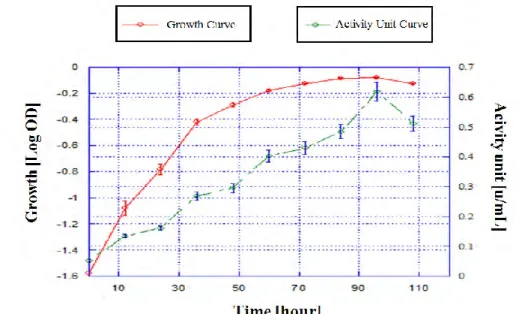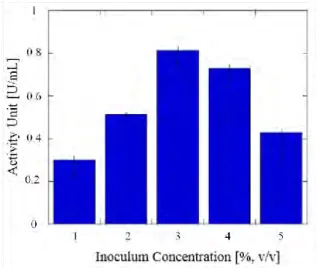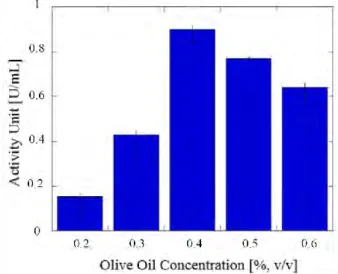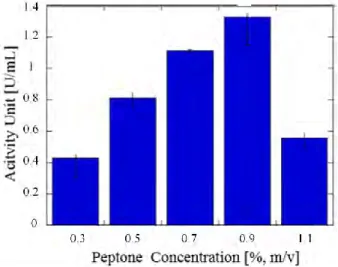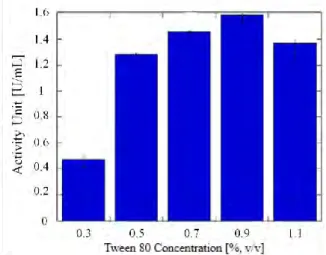HAL Id: hal-01954026
https://hal.archives-ouvertes.fr/hal-01954026
Submitted on 13 Dec 2018HAL is a multi-disciplinary open access archive for the deposit and dissemination of sci-entific research documents, whether they are pub-lished or not. The documents may come from teaching and research institutions in France or abroad, or from public or private research centers.
L’archive ouverte pluridisciplinaire HAL, est destinée au dépôt et à la diffusion de documents scientifiques de niveau recherche, publiés ou non, émanant des établissements d’enseignement et de recherche français ou étrangers, des laboratoires publics ou privés.
Production of Dry Extract Lipase from Pseudomonas
Aeruginosa by the Submerged Fermentation Method in
Palm Oil Mill Effluent
Heri Hermansyah, Ambar Maresya, Dwini Normayulisa Putri, Muhamad
Sahlan, Michel Meyer
To cite this version:
Heri Hermansyah, Ambar Maresya, Dwini Normayulisa Putri, Muhamad Sahlan, Michel Meyer. Production of Dry Extract Lipase from Pseudomonas Aeruginosa by the Submerged Fermentation Method in Palm Oil Mill Effluent. International Journal of Technology, 2018, 9 (2), pp.325-334. �10.14716/ijtech.v9i2.1511�. �hal-01954026�
OATAO is an open access repository that collects the work of Toulouse researchers and makes it freely available over the web where possible
Any correspondence concerning this service should be sent
to the repository administrator: tech-oatao@listes-diff.inp-toulouse.fr
This is an author’s version published in: http://oatao.univ-toulouse.fr/21128
To cite this version:
Hermansyah, Heri and Maresya, Ambar and Putri, Dwini Normayulisa and Sahlan, Muhamad and Meyer, Michel Production of Dry Extract
Lipase from Pseudomonas Aeruginosa by the Submerged Fermentation Method in Palm Oil Mill Effluent. (2018) International Journal of
Technology, 9 (2). 325-334. ISSN 2086-9614
PRODUCTION OF DRY EXTRACT LIPASE FROM PSEUDOMONAS
AERUGINOSA BY THE SUBMERGED FERMENTATION METHOD IN PALM OIL
MILL EFFLUENT
Heri Hermansyah1*, Ambar Maresya1, Dwini Normayulisa Putri1, Muhamad Sahlan1, Michel
Meyer2
1Department of Chemical Engineering, Faculty of Engineering, Universitas Indonesia, Depok, West Java, 16424, Indonesia
2Laboratoire de Génie Chimique, UMR CNRS/INPT/UPS, Université de Toulouse, 31432, France
ABSTRACT
Palm Oil Mill Effluent (POME) is an agro-industrial waste product with high availability and which contains high quantities of organic compounds that are necessary for microbial growth. Cultures of Pseudomonas aeruginosa were grown in POME to produce lipase using the submerged fermentation method. The objective of this study is to obtain the optimum value of lipase activity produced by the cultures of Pseudomonas aeruginosa using POME as the substrate through the submerged fermentation method and to obtain the dry extract of lipase. In the study, the one factor at a time (OFAT) method was applied, which allowed observation of the effect of inoculum and additional nutrient concentrations, such as Ca2+ ion, olive
oil, peptone and Tween 80, on the activity of lipase. These factors were investigated in shake flask fermentation at 30C over 96 hours. The activity unit of lipase was determined by the titrimetric reaction of olive oil hydrolysis using crude lipase. The optimum value of the lipase activity unit (1.327 U/mL) was gained when 3% (v/v) of inoculum, 4 mM of Ca2+ ion, 0.4%
(v/v) of olive oil, 0.9% (m/v) of peptone, and 0.9% of Tween 80 were added into the medium. Crude lipase was then dried using a spray dryer. Subsequently, 15.643 g of dry extract lipase was obtained from 500 mL of cell free supernatant. In further research, the lipase activity assay would be better achieved using the p-nitrophenyl palmitate hydrolysis method and examined by a spectrophotometer.
Keywords: Activity unit; Lipase; Palm oil mill effluent; Submerged fermentation 1. INTRODUCTION
Lipase is an enzyme which catalyzes the hydrolysis reaction of triglycerides into fatty acids and several types of glycerol, including di-acylglycerol and mono-acylglycerol (Mahadik et al., 2004). Recently, lipase has attracted significant interest for commercial production, as it has several advantages, including the fact that no cofactor is required, it is active in the interfaces of organic compounds, and facilitates a wide range of substrates (Hernández-Rodríguez et al., 2009). Therefore, lipase has many practical applications in industry, including as a biocatalyst for biodiesel synthesis, in bio-detergents, fine chemicals, waste water treatment, food additives, pharmaceuticals, leather processing and biomedical assays (Salihu et al., 2012).
*Corresponding author’s email: heri.hermansyah@ui.ac.id, Tel: +62-8129-3196-666, Fax: +62-21-7863-515 Permalink/DOI: https://doi.org/10.14716/ijtech.v9i2.1511
At present, the utilization of extracellular enzymatic activity in several microorganisms has become a preferred approach because of its potential as a biological source of industrially economic enzymes (Abd-Elhalem et al., 2015). There are a number of lipases produced by microorganisms, such as fungi including Candida, Geotrichum and Rhizopus, and bacteria including Bacillus, Pseudomonas, Burkholderia, Staphylococcus and Streptomyces (Treichel et al., 2010). Among these strains, the Pseudomonas lipase is the most important, since it has better stability, selectivity, and a wide range of substrate specificity (Bose & Keharia, 2013). Furthermore, lipase from Pseudomonas aeruginosa has been extensively manufactured and used in organosynthetic reactions (Karadzic et al., 2006).
Previous lipase production from Pseudomonas aeruginosa has been studied using Pseudomonas
aeruginosa san-ai (Karadzic et al., 2006), Pseudomonas aeruginosa AAU2 (Bose & Keharia,
2013), and Pseudomonas aeruginosa LX1 (Ji et al., 2010). Lipase from Pseudomonas
aeruginosa san-ai has been isolated and purified from the medium containing mineral cutting
oil with pH 10, obtaining excellent properties of lipase, including stability and activity in organic solvents (Karadzic et al., 2006). Besides, lipase from Pseudomonas aeruginosa AAU2 has also been produced by the submerged fermentation method using Jatropha SeedCake (JSC) as the carbon source, obtaining solvent tolerant lipase with a 11.4-fold higher enzyme yield in the optimum condition (Bose & Keharia, 2013). Another organic solvent tolerant lipase has also been produced from Pseudomonas aeruginosa LX1 (Ji et al., 2010). From its activity in transesterification reactions, lipase from Pseudomonas aeruginosa LX1 is considered to have potential for biodiesel production.
However, in the production of microbial lipase, production costs are a problem due to the high cost of the substrates. In order to lower these costs, agro-industrial waste can be used as the fermentation substrates. The utilization of agro-industrial waste would be a solution to the problem of disposal (Bose & Keharia, 2013). Palm Oil Mill Effluent (POME) is an agro-industrial waste product with high availability in Indonesia. Organic content, such as carbohydrates, protein, nitrogenous compounds, lipids and minerals, are present in POME (Wu et al., 2009). These contents are suitable for microbial growth and lipase production. Since POME is available in liquid form, application of submerged fermentation is a suitable method. The utilization of POME as a medium has been made by Salihu using Candida cylindracea with the submerged fermentation method, giving satisfactory results (Salihu et al., 2011). In addition, POME was also used as the basal medium by Wu et al. (2006) for protease production from wild type Aspergillus niger with the submerged fermentation method.
Submerged fermentation is one of the fermentation methods that have been used by industry for example in enzyme production, due to the better control of the parameters that affect the yield of the product (Hansen et al., 2015); temperature, pH and agitation are well-established for scaling the processes for industrial production capacity (Hansen et al., 2015). Lipase produced from submerged fermentation can be dried to obtain dry extract lipase. In a previous study, dry extract lipase was obtained from submerged fermentation by Suci et al. (2018) using Bacillus
subtilis as the source and waste cooking oil as the basal medium. Dry extract lipase is more
durable than liquid lipase and can be stored for a long time (Utami et al., 2017).
In this study, cultures of Pseudomonas aeruginosa were grown in POME to produce lipase using the submerged fermentation method, and the cell free supernatant was then dried to obtain dry extract lipase. In order to improve lipase production, the one factor at a time (OFAT) method was applied to investigate the influencing factors in lipase production. OFAT is a method in which the experimental factors are varied one at a time, with the remaining factors held constant (Bose & Keharia, 2013).
2. METHODOLOGY 2.1. Sample Collection
POME was collected in clean containers from a palm oil company at Bengkulu, Indonesia, and then stored at 4oC.
2.2. Inoculum Preparation and Microbial Culture
Pseudomonas aeruginosa B2290 was purchased from Indonesian Culture Collection (InaCC).
The strain was then grown on Nutrient Agar (NA) plates at 30−35C for 1 day. The isolate was maintained and preserved at 4C. Preparation of the inoculum was made by suspending
Pseudomonas aeruginosa from nutrient agar in 50 ml of sterile Luria Bertani broth using a
sterile inoculating loop, and incubating it using a water shaker bath at 170 rpm and 30C for 24 hours. The mixture was then used as the inoculum in further experiments.
2.3. Profile of Lipase Production
Inoculum of Pseudomonas aeruginosa was inoculated to an Erlenmeyer flask containing 100 ml of sterilized POME as the basal medium, and other nutrients including olive oil (0.2%, v/v), peptone (0.5%, w/v), CaCl2.2H2O (10mM) and Tween 80 (0.7%, v/v), The mixture was then
incubated in a water shaker bath at 30oC. 5 ml aliquots were taken after 0, 12, 24, 36, 48, 60,
72, 84, 96 and 108 h of incubation in order to analyze the bacterial growth using a spectrophotometer (660 nm) and the lipase activity using lipase activity assay.
2.4. Optimization of the Medium for Lipase Production
The optimization of the medium was made using the one factor at a time (OFAT) method. In this way, the experimental factors were varied one at a time, while the other factors were kept constant. The medium for the lipase production was prepared using sterilized POME as the basal medium, which contained olive oil (0.1–0.2%, v/v), peptone (0.3–1.1%, w/v), CaCl2.2H2O (4.0–12.0 mM) and Tween 80 (0.3–1.1%, v/v). The inoculum (1.0–5.0%, v/v) was
then added to the medium and incubated using a water shaker bath at 170 rpm and 30oC for 96
hours. After 96 hours of incubation, the culture was then centrifuged at room temperature, at 4000 rpm for 45 minutes, to obtain the cell-free supernatant. This was then filtered and assayed for the lipase activity calculation.
2.5. Lipase Activity Assay
The lipase activity was assayed by alkali titration using olive oil as the substrate according to work done by Pinhiero et al (2008) with several modifications in the titration method. Olive oil (10% m/v) was prepared and emulsified with PVA (5% m/v) in a 50 mM sodium phosphate buffer with a pH of 7.5. A crude enzyme sample of 2 mL was added into 18 mL of the emulsion and then incubated in a shaker for 15 minutes at 37°C and 150 rpm. After the reaction was stopped, 20 mL of 95% ethanol solution (1:1 v/v) was added to extract the fatty acids. Thereafter, three drops of 1% phenolphthalein were added as the titration indicator. Titration with 0.05 M NaOH then occurred, until the colour of the sample solution turned light violet, in order to calculate the amount of fatty acids liberated. The blanks for titration were run in similar steps, but the sample was added after the addition of ethanol. The lipase activity assay was performed in duplicate.
A unit activity of lipase was defined as the amount of enzyme which liberated 1 μmol of fatty acids per minute under the assay conditions. The protein concentration was estimated by following the Lowry method with BSA (fraction V) as the standard.
2.6. Production of Dry Extract Lipase
Scale-up production was conducted in a 30-L bioreactor with two six-flat-blade impellers. The bioreactor was filled with 20-L of POME as the basal medium, containing the optimum concentrations of olive oil, peptone, CaCl2.2H2O and Tween 80 obtained from the OFAT
method. The reactor was sterilized in situ and inoculated with the optimum concentration of prepared Pseudomonas aeruginosa inoculum, as described above. The fermentation was run at 30C for 96 hours. The fermentation temperature was maintained using a digital control system attached to the bioreactor.
The aliquots were taken after 96 hours and then centrifuged at room temperature, at 4000 rpm for 45 minutes. The cell-free supernatant was filtered and assayed for lipase activity. It was then collected and dried with a spray dryer at Center for Postharvest Research and Development (Balai Besar Penelitian dan Pengembangan Pascapanen) Bogor, with an inlet temperature of 150C and outlet temperature of 80C. Before being dried, skimmed milk powder (12%, w/v) was added to the cell-free supernatant. The dry extract lipase was then assayed for the lipase activity calculation.
3. RESULTS AND DISCUSSION 3.1. Profile of Lipase Production
In this experiment, growth of Pseudomonas aeruginosa and lipase activity was observed (Figure 1). The culture grew rapidly up until 36 hours of fermentation. After 36 hours, the culture started to grow more slowly and then continue to became stationary. After 96 hours the culture growth decreased.
The cells grew rapidly at the beginning because the nutrients in the medium were still at a high level. The cultures then reached the stationary phase because the nutrients in the medium were limited, which caused cell growth restriction (Yates & Smotzer, 2007). After 96 hours above, culture growth decreased and reached the death phase because the environment no longer supported any growth (Yates & Smotzer, 2007), such as the lack of nutrients and oxygen in the medium. In submerged fermentation, consumption of oxygen is proportional to the conversion of the substrate into the product (Gullo et al., 2014).
The level of lipase activity fluctuated and reached a maximum value of 0.618 U/ml after 96 hours of incubation, when the culture growth reached the stationary phase. This fluctuation occurred because the lipase produced by the cultures had been used to degrade lipids into free fatty acids, as the lipids could not passively cross cell membranes as the cell cultures consumed them (Papagora et al., 2013). After 108 hours, the lipase activity decreased because cell growth had reached the death phase.
This pattern also occurred in Pseudomonas aeruginosa AAU2 cultured in Jatropha Seed Cake (JSC) with the submerged fermentation method (Bose & Keharia, 2013). Lipase production in JSC started after 6 hours of inoculation with a maximum lipase activity value (0.433 U/ml) at the stationary phase, which occured after 60 hours of inoculation, after which production decreased (Bose & Keharia, 2013).
3.2. Optimization of Process Parameters for Lipase Production
Determination of the fermentation medium formulation will affect the profile of production, rate and yield of the lipase produced. The composition of the medium should be provided with inducer, carbon, nitrogen and trace elements (Salihu et al., 2011). Different concentrations of certain elements will have different effects. Therefore, in this research different concentrations of inoculum, Ca2+ ion, olive oil, peptone and Tween 80 were used to obtain the highest value of
the lipase activity unit.
3.2.1. Effect of different inoculum concentration
To investigate the influence of inoculum concentration, 1.0–5.0 % (v/v) of inoculum was tested. The highest activity of 0.813 U/ml was obtained from 3.0% (v/v) of inoculum concentration (Figure 2). The limited supply of nutrients in the medium could cause the inoculum to compete, meaning enzyme production will be affected (Salihu et al., 2011). In a similar way, a low concentration of inoculum could reduce enzyme secretion because of the small number of cells (Reddy et al., 2008).
Figure 2 Effect of different concentrations of inoculum on lipase activity unit
The concentration of inoculum used for each production might differ, depending on the type of bacteria and fermentation medium. In the production of Pseudomonas aeruginosa FW_SH-1 lipase for 3 days with yeast extract as the medium, the inoculum used was 5% (v/v). The effect of inoculum concentration has also been investigated in lipase production from Candida
Cylindracea using POME as the basal medium. The maximum activity of 6.2 U/ml was
obtained at about 2% (v/v) of inoculum concentration (Salihu et al., 2011).
3.2.2. Effect of different Ca2+ ion concentration
Ca2+ ions from CaCl2.2H2O were also added at a concentration of 4 mM–6 mM to investigate
their influence. The highest activity of 0.813 U/ml was obtained from 6 mM CaCl2.2H2O
(Figure 3). Calcium is an essential element in cell signalling and is required as a cofactor for many enzymes (Guragain et al., 2016). However, a high concentration of calcium ions could be toxic to the cells and decrease growth (Guragain et al., 2016). Other research conducted by Vasiee et al. (2016) reported that optimal enzyme production conditions from Bacillus cereus
incubated at 37C for 48 h were achieved with 24.23 mM MgCl2 together with a coriander seed
extract (CSE)/yeast extract ratio of 16.9 (m/m) and a concentration of 2.37 g/L of olive oil.
Figure 3 Effect of different concentrations of Ca2+ ions on lipase activity unit
3.2.3. Effect of different olive oil concentrations
The biosynthesis of enzymes may be affected by the varying sources and the different concentrations of carbon and nitrogen (Sharma et al., 2001). In this study, concentrations of 0.2–0.6 % (v/v) olive oil were investigated. Pseudomonas aeruginosa was shown to have the best lipase activity of 0.899 U/ml at 0.4 % (v/v) olive oil (Figure 4). Carbohydrates were mainly used as the carbon source in the carbon metabolism of microorganisms, but the microorganisms can utilize lipids as the carbon source in the presence of lipases (Papagora et al., 2013).
Figure 4 Effect of different concentrations of olive oil on lipase activity unit
In many other researches, lipase production depends on the presence of an inducer, and oil commonly acts as a good lipase inducer (Sharma et al., 2001). Lipase produced in this medium is hydrolyzed, and subsequently glycerol and fatty acids are released. The glycerol is consumed by microorganisms as the carbon source and the free fatty acids are consumed as inducers to form lipase (Goncalves et al., 2014). The addition of olive oil to the fermentation medium gave a positive result due to the oleic acid composition in the oil. (Dalmau et al., 2001). However, a high concentration of olive oil might decrease the oxygen transfer in the medium and have a negative effect on lipase production (Goncalves et al., 2014). Based on research conducted by
Papagora et al. (2013), the concentration of olive oil which influenced lipase production over 72 hours of fermentation time at 30C was 19 g/L or 1.9% (m/v), with an activity value of 7.44 ± 0.28 U/mL.
According to a study of lipase enzyme production from Candida cylindracea conducted by Salihu et al (2011), the highest lipase activity unit with a value of 5.92–5.96 U/mL was reached when 0.2% (m/v) olive oil was added to the POME medium for 6-day fermentation.
3.2.4. Effect of different peptone concentrations
In order to investigate the influence of peptone, concentrations of 0.3–1.1 % (w/v) were tested. The highest activity of 1.327 U/ml was obtained at 0.9% (v/v) of peptone (Figure 5). The addition of peptone was found to have a positive effect on cell growth, as it is an important nutrient for growth (Rajendran & Thangavelu, 2012). However, a high concentration of peptone was found to have a negative effect on lipase production as an increase in protease production might cause proteolysis within it (Rajendran & Thangavelu, 2012). The protease production occured along with the bacterial growth and accumulated in the stationary phase (Wu et al., 2006), as in lipase production.
Based on research by Cadirci & Yasa (2010) in their study of Pseudomonas fluorescens P21 lipase production in the nutrient medium for 12 hours, the addition of 0.3% (m/v) peptone gave the highest activity of 15 U/L. This value was higher than those of tripton and casein.
Figure 5 Effect of different concentrations of peptone on lipase activity unit 3.2.5. Effect of different tween 80 concentration
The presence of surfactant was found to have a positive impact on increasing the yield (Sharma et al., 2001). In this study, concentrations of 0.3–1.1 % (v/v) Tween 80 were investigated.
Pseudomonas aeruginosa was shown to have the best lipase activity of 1.588 U/ml at 0.9%
(v/v) of Tween 80 (Figure 6). Tween 80 is a surfactant which could induces the production of lipase as it enhances cell permeability and facilitates lipase transport through the cell membrane (Dalmau et al., 2001). In addition, it contains oleic acid, which is an intrinsic carbon source for bacterial growth (Li et al., 2004). It has a positive effect on lipase activity, but at higher concentrations it might inhibit it.
According to research by Bose & Keharia (2013) on the production of Pseudomonas
aeruginosa AAU2 lipase in jatropha seed cake substrate for 60 hours, the addition of 0.05%
(v/v) Tween 80 yielded the highest value of the lipase activity unit, at 4.0–5.0 U/mL. This value is higher than the addition of Triton X, Tween 20, Tween 40 or Tween 60.
Figure 6 Effect of different concentrations of Tween 80 on lipase activity unit 3.3. Dry Extract Lipase Production
Scale-up fermentation was conducted in submerged fermentation for 96 hours using POME as the basal medium and with the addition of 3% (v/v) of Pseudomonas aeruginosa inoculum, 0.9% (m/v) of peptone, 0.4% (v/v) of olive oil, 4 mM of Ca2+ ions and 0.9% of Tween 80.
These compositions were obtained from the OFAT method. The aliquots from fermentation were centrifuged to obtain cell free supernatant. The supernatant was then dried with a spray dryer. From 500 mL of cell free supernatant, 15.643 g of dry extract lipase was obtained. This had a lipase activity unit of 28.5 U/g and specific lipase activity of 2.417 U/g proteins. These results were higher than those from the experiment conducted by Suci et al (2018), with a lipase activity unit of 28 U/g solid and specific lipase activity of 1.44 U/g proteins. The dry extract lipase obtained by Suci was from Bacillus subtilis inoculated in submerged fermentation using waste cooking oil as the basal medium for 84 hours. The differing results could be due to the differences in bacteria, medium and fermentation time.
A spray drying process was needed to remove the water content in the cell free supernatant to obtain stable lipase; this process was more efficient and economical compared to the freeze drying process (Utami et al., 2017). In addition, commercial lipases are usually sold in dry form to simplify distribution and ease usage.
4. CONCLUSION
The activity unit of lipase from Pseudomonas aeruginosa using POME as the basal medium reached a maximum value of 1.327 U/mL from the crude form. The optimum values of the lipase activity unit were gained when 3% (v/v) of inoculum, 0.9% (m/v) of peptone, 0.4% (v/v) of olive oil, 4 mM of Ca2+ ions, and 0.9% of Tween 80 were added into the medium and
fermented for 96 hours. The dry extracellular lipase obtained had an activity unit of 28.5 U/g, with a specific activity of 2.417 U/g proteins. The utilization of POME as an alternative medium would result in a considerable reduction in the cost of lipase production. The values of the lipase activities would achieve better results if the experiment used the hydrolysis reaction of p-nitrophenyl palmitate and examination by spectrophotometer.
5. ACKNOWLEDGEMENT
The authors are grateful for the research support provided by Ministry of Research, Technology, and Higher Education through International Research Collaboration Grant Program and for the publication support provided by the United States Agency for International Development (USAID) through the Sustainable Higher Education Research
Alliance (SHERA) Program for Universitas Indonesia’s Scientific Modeling, Application, Research and Training for City-centered Innovation and Technology (SMART CITY) Project, Grant #AID-497-A-1600004, Sub Grant #IIE-00000078-UI-1.
6. REFERENCES
Abd-Elhalem, B.T., El-Sawy, M., Gamal, R.F., Abou-Taleb, K.A., 2015. Production of Amylases from Bacillus amyloliquefaciens under Submerged Fermentation using Some Agro-industrial By-products. Annals of Agricultural Sciences, Volume 60(2), pp. 193–202 Ali, C.H., Mbading, S.M., Liu, J.-F., Yang, S.-Z., Gu, J.-D., Mu, B.-Z., 2015. Significant
Enhancement of Pseudomonas aeruginosa FW_SH-lipase Production using Response Surface Methodology and Analysis of its Hydrolysis Capability. Journal of the Taiwan
Institute of Chemical Engineers, Volume 52, pp. 7–13
Bose, A., Keharia, H., 2013. Production, Characterization and Applications of Organic Solvent Tolerant Lipase by Pseudomonas aeruginosa AAU2. Biocatalysis and Agricultural
Biotechnology, Volume 2(3), pp. 255–266
Cadirci, B.H., Yasa, I., 2010. An Organic Solvents Tolerant and Thermotolerant Lipase from
Pseudomonas fluorescens P2. Journal of Molecular Catalysis B: Enzymatic, Volume 64(3–
4), pp. 155–161
Dalmau, E., Montesinos, J.L., Lotti, M., Casas, C., 2000. Effect of Different Carbon Sources on Lipase Production by Candida rugosa. Enzyme and Microbial Technology, Volume 26(9– 10), pp. 657–663
Gonçalves, F.A.G., Colen, G., Takahashi, J.A. 2014. Yarrowia lipolytica and Its Multiple Applications in the Biotechnological Industry. The Scientific World Journal, Volume 2014, pp. 1–14
Gullo, M., Verzelloni, E., Canonico, M., 2014. Aerobic Submerged Fermentation by Acetic Acid Bacteria for Vinegar Production: Process and Biotechnological Aspects. Process
Biochemistry, Volume 49(10), pp. 1571–1579
Guragain, M., King, M.M., Franklin, M.J., 2016. The Pseudomonas aeruginosa PAO1 Two-component Regulator CarSR Regulates Calcium Homeostasis and Calcium-induced Virulence Factor Production through Its Regulatory Targets CarO and CarP. Journal of
Bacteriology, Volume 198(6), pp. 951–963
Hansen, G.H., Lübeck, M., Frisvad, J.C., Lübeck, P.S., Andersen, B., 2015. Production of Cellulolytic Enzymes from Ascomycetes: Comparison of Solid State and Submerged Fermentation. Process Biochemistry, Volume 50(9), pp. 1327–1341
Hernández-Rodríguez, B., Córdova, J., Bárzana, E., Favela-Torres, E., 2009. Effects of Organic Solvents on Activity and Stability of Lipases Produced by Thermotolerant Fungi in Solid-state Fermentation. Journal of Molecular Catalyst B: Enzymatic. Volume 61(3–4), pp. 136–142
Ji, Q., Xiao, S., He, B., Liu, X., 2010. Purification and Characterization of an Organic Solvent-tolerant Lipase from Pseudomonas aeruginosa LX1 and its Application for Biodiesel Production. Journal of Molecular Catalysis B: Enzymatic, Volume 66(3–4), pp. 264–269 Karadzic, I., Masui, A., Zivkovic, L.I., Fujiwara, N., 2006. Purification and Characterization of
an Alkaline Lipase from Pseudomonas aeruginosa Isolated from Putrid Mineral Cutting Oil as Component of Metalworking Fluid. Journal of Bioscience and Bioengineering, Volume 102(2), pp. 82–89
Li, C.Y., Cheng, C.Y., Chen, T.L., 2004. Fed-batch Production of Lipase by Acinetobacter
radioresistens using Tween 80 as the Carbon Source. Biochemical Engineering Journal,
Mahadik, N.D., Bastawde, K.B., Puntambekar, U.S., Khire, J.M., Gokhale, D.V., 2004. Production of Acidic Lipase by a Mutant of Aspergillus niger NCIM 1207 in Submerged Fermentation. Process Biochemistry, Volume 39(12), pp. 2031–2034
Papagora, C., Roukas, T., Kotzekidou, P., 2013. Optimization of Extracellular Lipase Production by Debaryomyces hansenii Isolates from Dry-salted Olives using Response Surface Methodology. Food and Bioproducts Processing, Volume 91(4), pp. 413–420 Pinhiero, T.D., Menoncin, S., Domingues, N.M., Oliviera, D.D., Treichel, H., Di Luccio, M.,
Freire, D.M., 2008. Production and Partial Characterization of Lipase from Penicillium
verrucosum Obtained by Submerged Fermentation of Conventional and Industrial Media. Ciência e Tecnologia de Alimentos, Volume 28(2), pp. 444–450
Rajendran, A., Thangavelu, V., 2012. Optimization and Modeling of Process Parameters for Lipase Production by Bacillus brevis. Food Bioprocess Technology, Volume 5(1), pp. 310– 322
Reddy, L., Wee, Y., Yun, J., Ryu, H., 2008. Optimization of Alkaline Protease Production by Batch Culture of Bacillus sp. RKY3 through Plackett-Burman and Response Surface Methodological Approaches. Bioresource Technology, Volume 99(7), pp. 2242–2249 Salihu, A., Alam, M.Z., AbdulKarim, M.I., Salleh, H.M., 2011. Optimization of Lipase
Production by Candida cylindracea in Palm Oil Mill Effluent based Medium using Statistical Experimental Design. Journal of Molecular Catalysis B: Enzymatic, Volume 69(1–2), pp. 66–73
Salihu, A., Alam, M.Z., AbdulKarim, M.I., Salleh, H.M., 2012. Lipase Production: An Insight in the Utilization of Renewable Agricultural Residues. Resources, Conservation and
Recycling, Volume 58, pp. 36–44
Sharma, R., Chisti, Y., Banerjee, U.C., 2001. Production, Purification, Characterization, and Applications of Lipases. Biotechnology Advances, Volume 19(8), pp.627–662
Suci, M., Arbianti, R., Hermansyah, H., 2018. Lipase Production from Bacillus subtilis with Submerged Fermentation using Waste Cooking Oil. IOP Conference Series: Earth and
Environmental Science, Volume 105, pp. 1–6
Treichel, H., Oliveira, D., Mazutti, M.A., Luccio, M.D., Oliveira, J.V., 2010. A Review on Microbial Lipases Production. Food and Bioprocess Technology, Volume 3(2), pp. 182– 196
Utami, T.S., Hariyani, I., Gandhi, A., Hermansyah, H., 2017. Production of Dry Extract Extracellular Lipase from Aspergillus niger by Solid State Fermentation Method to Catalyze Biodiesel Synthesis. Energy Procedia, Volume 136, pp. 41–46
Vasiee, A., Behbahani, B.A., Yazdi, F.T., Moradi, S., 2016. Optimization of the Production Conditions of the Lipase Produced by Bacillus cereus from Rice Flour through Plackett-Burman Design (PBD) and Response Surface Methodology (RSM). Microbial
Pathogenesis, Volume 101, pp. 36–43
Wu, T.Y., Mohammad, A.W., Jahim, J.Md., Anuar, N., 2006. Investigations on Protease Production by a Wild-type Aspergillus terreus Strain using Diluted Retentate of Pre-filtered Palm Oil Mill Effluent (POME) as Substrate. Enzyme and Microbial Technology, Volume 39(6), pp. 1223–1229
Wu, T.Y., Mohammad, A.W., Jahim, J.Md., Anuar, N., 2009. A Holistic Approach to Managing Palm Oil Mill Effluent (POME): Biotechnological Advances in the Sustainable Reuse of POME. Biotechnology Advances, Volume 27(1), pp. 40–52
Yates, G.T., Smotzer, T., 2007. On the Lag Phase and Initial Decline of Microbial Growth Curves. Journal of Theoretical Biology, Volume 244(3), pp. 511–517
